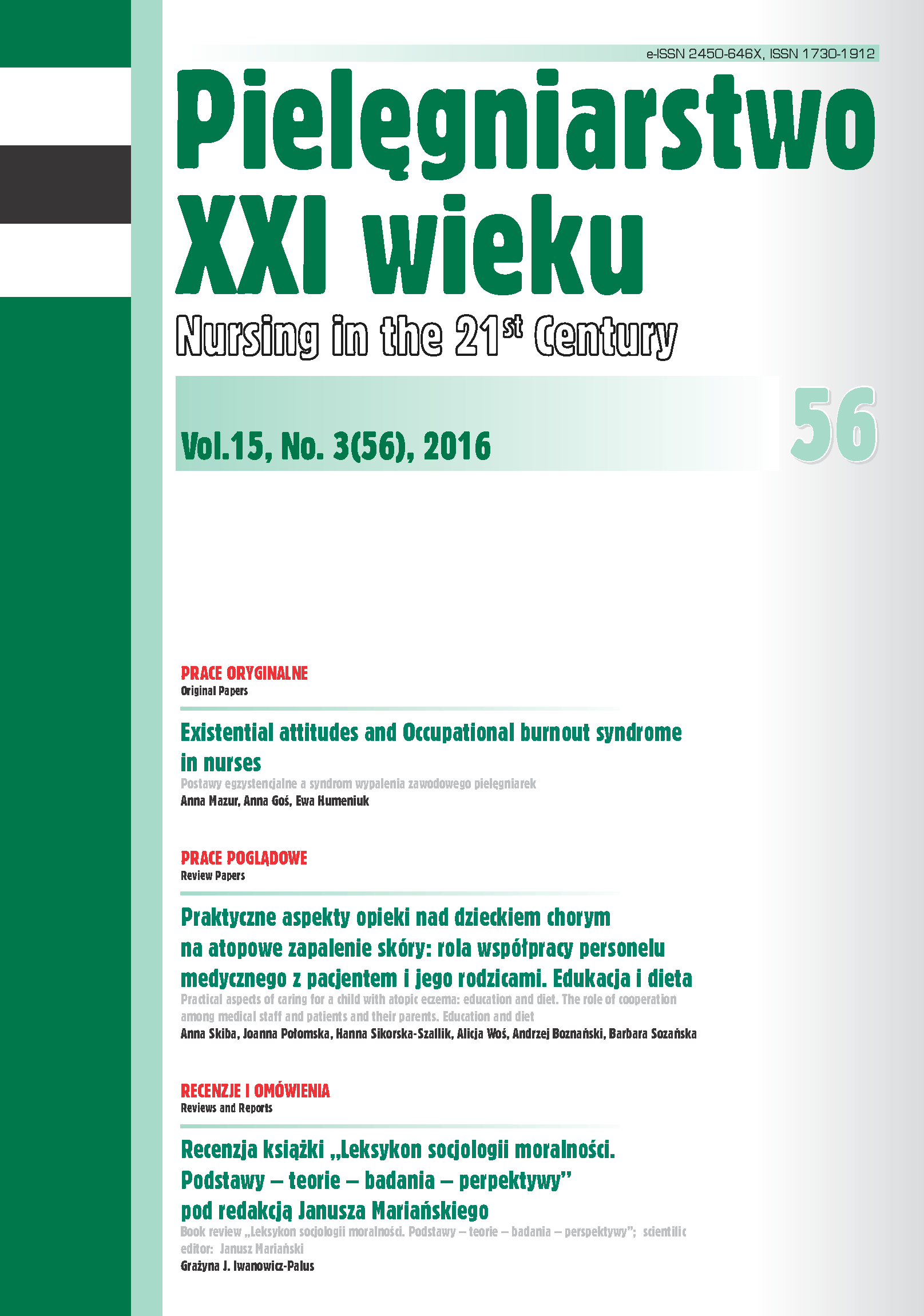Birthing school – patient’s assessmenton the influence of classes on parturition
DOI:
https://doi.org/10.1515/pielxxiw-2016-0023Keywords:
birthing school, pregnancy, childbirthAbstract
BIRTHING SCHOOL – PATIENT’S ASSESSMENT ON THE INFLUENCE OF CLASSES ON PARTURITION
Pregnancy is a woman’s physiological state, covering the period from conception to birth. It is an important time in the life of every woman and the child’s father. Often, the parents-to-be find the new situation difficult. Childbirth classes may prove helpful during pregnancy and childbirth for mothers and fathers. The aim of the study was to evaluate the effect of antenatal classes on parturition, according to the assessment of patients. The study was conducted at the Cardinal Stefan Wyszynski Provincial Specialist University Hospital in Lublin at the maternity ward on a group of 155 patients by means of diagnostic survey. The survey, by which the research material was collected, has been developed with the author’s own method. It has been shown that education and age of the participants influence the decision to use the services of childbirth education classes. Furthermore, the knowledge of breathing techniques, the use of birthing facilities, development of a plan for parturition and knowledge of methods of pain relief of childbirth have no impact on its duration. It was also shown that it is important to use relevant childbirth positions.
References
1. Fijałkowski W. (1989) Poród naturalny po przygotowaniu w szkole rodzenia. Warszawa: PZWL.
2. Kwiatek M. i wsp. Szkoła rodzenia-profil pacjentek oraz wpływ zajęć na przebieg porodu i stan noworodka. Medycyna Ogólna i Nauki o Zdrowiu. 2011; 17 (3): 111-115.
3. Piziak W. Wpływ przygotowania psychofizycznego w szkole rodzenia na przebieg ciąży i porodu. Rzeszów: Przegląd Medyczny Uniwersytetu Rzeszowskiego. 2009; 3: 282-292.
4. Sioma-Markowska U, Poręba R. Analiza postawy ojców w porodzie rodzinnym w materiale Katedry i Oddziału Klinicznego Ginekologii i Położnictwa w Tychach Śląskiej Akademii Medycznej. Perinatologia. Neonatologia i Ginekologia. 2008; 1(2): 142-143.
5. Chazan B, Bręborowicz G.(red). Położnictwo i Ginekologia. Warszawa: PZWL; 2010, s.58-67.
6. Kołomyjec P, Suchocki S, Kędra-Rakoczy M. Wykształcenie i zachowania prozdrowotne ciężarnych biorących udział w zajęciach szkoły rodzenia oraz ich wpływ na przebieg porodu i stan noworodka. Kliniczna Perinatologia i Ginekologia. 2007; 43 (3): 57-60.
7. Kozłowska J, Curyło M. Skutki przygotowania kobiet do porodu i połogu według zasad psychoprofilaktyki porodowej. Now Lek. 2005; 74; 159-162.
8. Małecka A, Nowak Z. Opinia badanych kobiet w czasie ciąży dotycząca uczestnictwa w szkole rodzenia jako formy przygotowania do porodu. Przegląd Lekarski. 2014;71(8):437-440.
9. Swieboda P, Filip R, Prystupa A, Drozd M. Assessment of pain: types, mechanism and treatment. Annals of agricultural and environmentalmedicine. Special Issue 2013;1: 2-7.
10. Dziechciaż M, Balicka-Adamik L, Filip R. The problem of pain in old age. Annals of agricultural and environmentalmedicine. 2013; 1: 35-38.
11. Grignaffinii WSP. Childbirth preparation courses: obstetrical and neonatal evaluation, Acta Biomed AteneoParmense. 2000; 71 (1):701-707.
12. Sadowska M, Kędzierska A, Wdowiak A, Brześcińska A. Efektywność funkcjonowania szkół rodzenia w opinii kobiet. EuropeanJournal of Medical Technologies; 2013; 1(1): 39-47.
13. Ćwiek D, Grochans E, Sowińska-Gługiewicz I, Wysiecki P. Analysis of some pro-health behaviors of pregnant women after a childbirth education class. Wiad Lek. 2004; 57 (1):48-51.
Published
Issue
Section
License
Copyright (c) 2016 Authors

This work is licensed under a Creative Commons Attribution-NonCommercial-NoDerivatives 3.0 Unported License.




